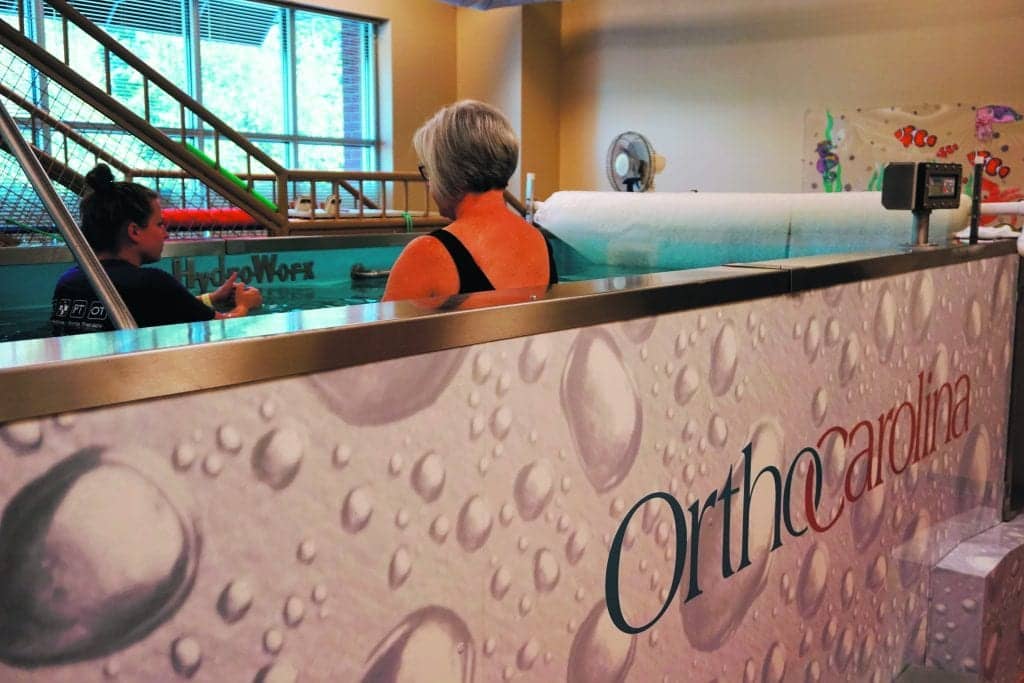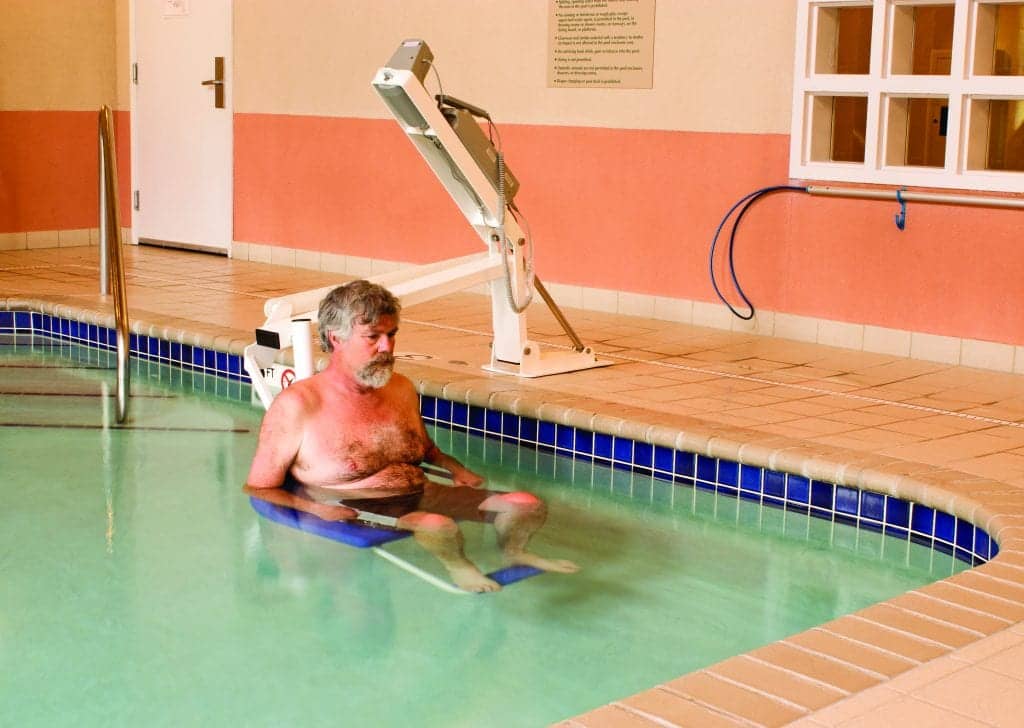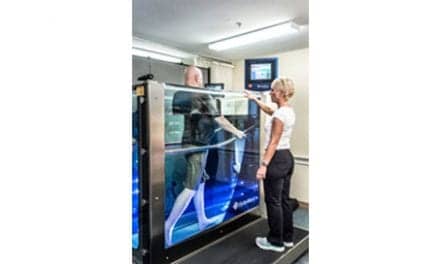Offering patients a safe and challenging environment where therapists can use their creativity to lead patients through recovery is an idea that holds water.
By Cheryl F. Bennett, PTA, CGT, and Elizabeth A. Nichols, PT, ATC
The longer a person does not use a body part that is affected by chronic pain or is in need of rehabilitation, the more inflexible that person becomes. The members of this patient population fear pain and as a result may become fearful of movement. The most common conditions for which a patient may experience pain anxiety that leads to stalled progress include lower back pain and failure to strengthen the core, as well as limb stiffness and unease moving the arms, knees, and ankles. Postoperative and chronic pain patients are also more susceptible to becoming stuck than other physical therapy patients.
Aquatic therapy can help get patients over the hump and jump-start the healing process. Immersion in water changes the amount of weight bearing on the joints, and so with each depth, it becomes easier for an individual to stand on the injured part. The water reduces the stress and pressure of significant body weight on muscles, joints, tendons and bones that would be felt during activities on dry land.
Staying Afloat: Transition to the Aquatic Environment
Entering the water displaces the body weight that a patient would place on his or her joints outside of the pool. Patients who are highly sensitive to their pain level can still do well in the aquatic setting as long as the therapist ensures that the person concentrates wholly on the healing process. Some patients who are unable to swim may also be apprehensive about pool therapy, but even patients who are non-swimmers can successfully complete an aquatic therapy program.
At OrthoCarolina, a Charlotte, NC-headquartered provider of orthopedic care to the North Carolina and South Carolina region, patients are either referred to aquatic therapy by a physician, or their physical therapist may feel that they would benefit from the unweighting that the water offers. The PT performs an evaluation and designs a plan of care for the pool therapist to follow. While there is a hand-off from PT to pool therapist, the care approach should always be structured as a team effort rather than total patient management falling on one therapist.
Product Resources
Pools, spas, and accessories for water-based rehabilitation are available from these manufacturers:
Aquatic Access Inc
www.aquaticaccess.com
Endless Pools
www.endlesspools.com
Hudson Aquatic Systems LLC
www.hudsonaquatic.com
HydroWorx
www.hydroworx.com
Nespa Tiled Spas
www.tiledspas.com
NZ Manufacturing
https://nzcordz.com
Sprint Aquatics
www.sprintaquatics.com
Sure Hands Lift and Care Systems
www.surehands.com
SPRI Products
www.spri.com
SwimEx
www.swimex.com
Signs of Progress: Moving Beyond the Hump
The goal of aquatic therapy is to help facilitate a decrease in the patient’s pain symptoms so the patient may have a more active lifestyle. Therapeutic approaches in the pool may mimic many land-based physical therapy exercises. Since the buoyancy of the water allows for decreased weight-bearing and easier movement of joints, patients can often progress more quickly than they would out of the water. Exercise and activity in the pool is not always pain-free, but it typically decreases pain.
Pool tools can enhance the water experience through a variety of movements that help patients regain flexibility, strength, and endurance, and often resemble pool toys found at a typical neighborhood or community pool. The most common tools include pool noodles, kickboards, ankle weights, and foam dumbbells that aid in preparing the patient for more weight-bearing land-based walking or gentle running. Underwater treadmills allow patients to ambulate earlier than they would outside the pool, and the therapist can monitor the patient’s gait and gait pattern. OrthoCarolina has underwater treadmills in both of its aquatic therapy pools at two different pool locations. There are several manufacturers for these types of pool products, including Hudson Aquatic Systems LLC, Angola, Ind; HydroWorx, Middletown, Pa; and SwimEx, Fall River, Mass.
Rules of the Pool: Patient Compliance
Patient compliance in traditional physical therapy can sometimes taper off but for success in an aquatic therapy program consistent attendance is essential. Because water is perceived as relaxing, pool patients often feel more comfortable in the aquatic setting and are more compliant meeting their appointment schedule. The decreased weight-bearing properties of water makes their bodies feel lighter which can be comforting and, in turn, can improve attendance.
As with land-based physical therapy compliance with aquatic physical therapy can decrease once the patient’s program has been completed. Patients receive home program copies of the exercise plan at their final visit and are encouraged to continue the plan on their own at a YMCA or community pool, but most don’t keep up the routine as stringently without a therapist overseeing them.
Safe Entry, Safe Exit
Individuals affected by balance issues, neurological conditions, or those who have mobility issues that restrict them from safely entering a water environment such as a large in-ground or above-ground swimming pool will benefit from a pool lift approved for use under the Americans with Disabilities Act (ADA). Several manufacturers offer devices to the PT market for these types of pools designed to provide convenience and a high level of safety.
One example is the IGAT-180 series of lifts available from Aquatic Access Inc, Louisville, Ky, designed to operate using water pressure. Devices in this series can lift up to 400 pounds but be modified for heavier users. A seat belt is provided with each lift as well as a flip-up footrest. The company’s IGAT-180/135 pool lift can accommodate side-to-side transfers and is engineered to provide 135-degree seat rotation for use with pools or spas that have seats or benches built in.
Another manufacturer, Pine Island NY-based SureHands Lift & Care Systems, offers the Wheelchair-to Water Pool Lift built to move the user directly from the wheelchair into the water. This lift has a mobile design and is powered by rechargeable batteries. ADA-compliant lifts can also be found through Spectrum Aquatics, Missoula, Mont. The company’s electric-powered lifts include the Freedom ADA-Compliant Pool Lift and Aspen ADA-Compliant Pool Lift, both of which offer a 350-pound lifting capacity and 90 lifts per battery charge.

Double Dip: Purchasing a Second Pool
For OrthoCarolina, geography played an important role in adding a second pool. With 40 offices spread out across North Carolina and South Carolina, a high demand for aquatic therapy already existed at a central physical therapy office in Charlotte. Because the company worked closely with university athletes in north Charlotte, it made the decision to add a second pool at an office in that location. The second pool offered more convenience to patients for recovery and therapeutic purposes as well as athlete training and rehabilitation.
Proper space surrounding any aquatic therapy pool is imperative. With the additional pool, the stairs were changed from the design of the first pool, adding two handrails to make it easier for non-weight bearing patients to enter the water. The second pool eventually became busy enough to add an additional pool therapist. While there are no plans at this time for a third pool at OrthoCarolina, a growing patient population could mean more location-based demand for physical therapy pools.
Making the decision to add aquatic therapy capabilities for any outpatient clinic should be carefully considered. Practice owners and managers must evaluate the hard realities of budgets, floor space, staffing, and the ongoing maintenance that pool installations of any size require, whether single-user modular systems or in-ground pools that can accommodate many users at once. Marketing these facilities and raising awareness to generate referrals is also part of the equation that must be factored into a plan for overall success. The most important among these variables, however, is the practice’s patient population that will be served by an aquatic therapy program. Offering these individuals a safe and challenging environment where therapists can apply their own creativity to lead patients through recovery while minimizing their pain is a goal that will hold water for a long, long time. PTP
Cheryl F. Bennett, PTA, CGT, graduated from Central Piedmont Community College with an Associate Degree in Applied Science in 1997. She has been with OrthoCarolina in Charlotte since 1998 and has been an aquatic therapist at the University Therapy location for 7 years. Her clinical background is in orthopedics with an emphasis on foot and ankle and aquatics.
Elizabeth A. Nichols, PT, ATC, graduated from the Mayo School of Health Related Sciences in 1988 and received a Masters of Health Science and Athletic Training Certification in 1993. She joined OrthoCarolina in 1991 and became manager of the University therapy office in 1993. Her clinical background includes sports medicine and orthopedics. For more information, contact [email protected].
Pool Lifts for Safer Transfers
Aquatic facilities have safe options for moving non-ambulatory clientele into the water
By Frank Long, Editorial Director, Physical Therapy Products

When a physical therapy practice makes the decision to install aquatic facilities that decision may be predicated on the assumption that a broad spectrum of clientele will use the facilities. Regardless of whether athletes and fitness populations are targeted early on as the main clientele, once an above- or in-ground pool is installed the door will be opened to individuals all along the rehabilitation curve, including those who are affected by a mobility impairment.
Individuals who have a lower extremity impairment may find walking difficult or be unable to walk. These individuals may also use a mobility device such as a wheelchair or walker and will therefore need the means to transfer safely and comfortably into the water. To serve the needs of this patient population clinic owners and directors will want to consider installing an ADA-approved pool lift to provide safe access into and out of the therapy pool. A pool lift approved for use under the Americans with Disabilities Act (ADA) can be a solution to these challenges. Several manufacturers offer devices to the PT market for all types of pools that are built to offer convenience and a high level of safety.
Water-Powered Lift for Access That is Clean and Green
The IGT-180 series of lifts available from Aquatic Access Inc, Louisville, Ky, are built to operate on water pressure, providing a green source of power that can help reduce energy costs. Devices in this series can lift up to 400 pounds but be modified for heavier users. A seat belt is provided with each lift as well as a flip-up footrest. The company’s IGAT-180/135 pool lift can accommodate side-to-side transfers and is engineered to provide 135-degree seat rotation for use with pools or spas that have seats or benches built in. Aquatic Access also offers the Pool Lift Model AG72 for facilities equipped with above-ground high-wall therapy pools. This lift has a vertical seat travel of 51 inches and a manual 360-degree seat turn. For other above-ground installations or for use with freestanding nursing home tubs, the Pool Lift AG-60 provides 42 inches of vertical seat travel as well as a manual 360-degree seat turn.
Mobile and Ceiling-Mount Pool Lifts
Pine Island, NY-based SureHands Lift & Care Systems offers the Wheelchair-to Water Pool Lift, built to move the user directly from the wheelchair into the water. This lift has a mobile design and is powered by rechargeable batteries. The unit is built to engage and disengage easily from the floor socket and can be rolled away from the pool when not in use. An emergency stop button is built in to halt all motion of the device’s lifting arm. This lift has four castors and is designed to be compact and fold up easily.
Another option SureHands Lift & Care systems provides to help mobility-impaired individuals access a therapy pool is the SureHands Body Support and ceiling motor. This solution may be useful for situations where a floor socket for a poolside lift cannot be installed. The ceiling motor option can expand the lifting range available to the clinic and is reported by the company to be particularly useful for facilities that have large numbers of wheelchair users. Because it is mounted to the ceiling, it may also be advantageous for pools that have narrow decks. This configuration also allows the wheelchair user to operate the ceiling-mounted pool lift independently with the use of a handheld remote.
Stabilized Support and Ramp Option
ADA-compliant lifts can also be found through Spectrum Aquatics, Missoula, Mont. The company’s line of electric-powered lifts include the Freedom ADA-Compliant Pool Lift and Aspen ADA-Compliant Pool Lift, both of which offer a 350-pound lifting capacity and 90 lifts per battery charge. The company’s line of water-powered lifts include the ADA/ABA-compliant Gallatin Water Power Assisted Access Lift for in-ground pools and spas without customization, and the Glacier Pool Lift, a vertical lift platform designed to accommodate a wheelchair for individuals who require stabilized support for entry. For facilities that want a manual-powered pool lift Spectrum Aquatics offers its Elkhorn model pool lift, which can be used for above- or in-ground pools and spas. The Elkhorn has a single anchor point, and the company reports that while the lift weighs less than 60 pounds it has a 400-pound operating load capacity. According to the company, the Elkhorn provides easy rotation and is “virtually frictionless.”
Spectrum Aquatics also offers a ramp option that may be useful for wheelchair users as well as clientele who are ambulatory. This product, known as the Access Ramp, is 15 feet long and 36 inches wide, and custom fabricated for each pool for which it is used. The Access Ramp is designed to support a 400-pound load and has wheels that allow it to be removed from the pool as needed. PTP





